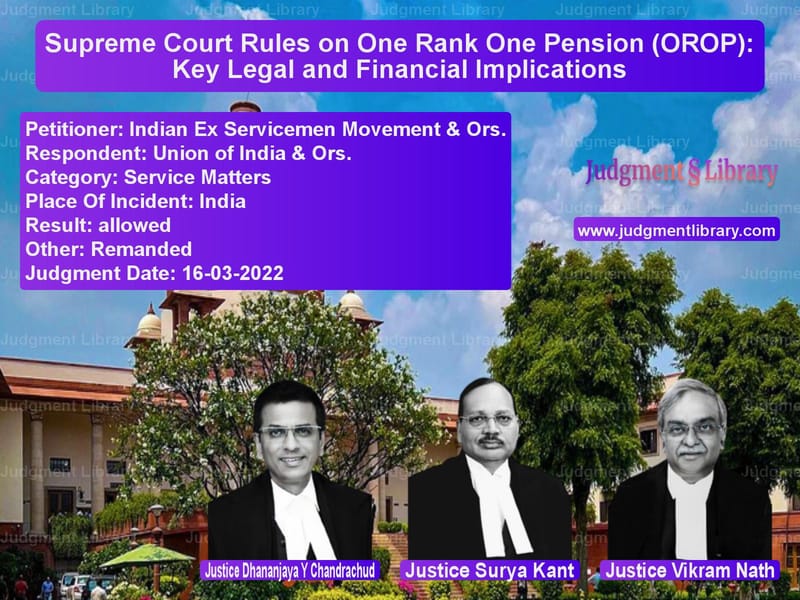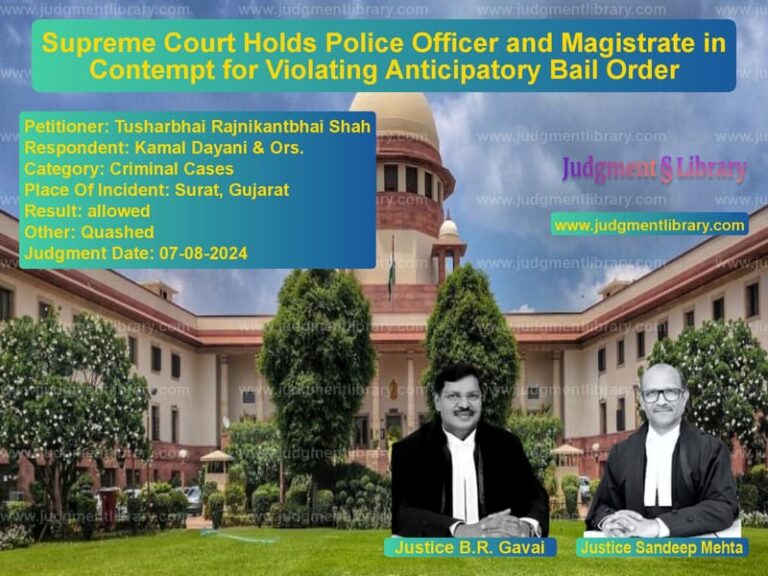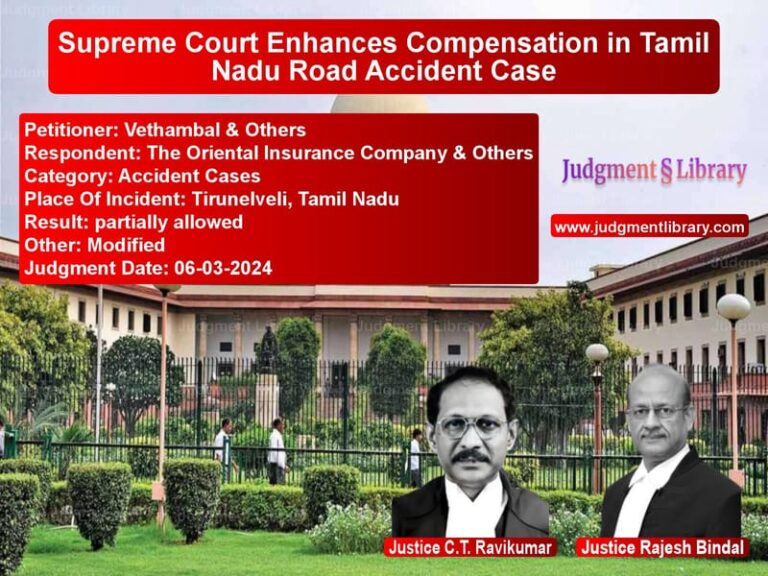Supreme Court Rules on One Rank One Pension (OROP): Key Legal and Financial Implications
The case of Indian Ex Servicemen Movement & Ors. vs. Union of India & Ors. is a landmark ruling addressing the legality of the implementation of the One Rank One Pension (OROP) scheme for retired personnel of the Indian Armed Forces. The Supreme Court’s judgment clarifies the principles of pension uniformity and the financial implications of periodic revisions.
The dispute arose when ex-servicemen challenged the government’s method of implementing OROP, arguing that the principle had been altered to ‘One Rank Multiple Pensions’ due to the lack of automatic revisions. The petitioners contended that this violated their constitutional rights under Articles 14 and 21. The Supreme Court, in its final ruling, upheld the government’s policy while directing the authorities to conduct a fresh pension re-fixation exercise.
Background of the Case
The case revolved around the government’s 2015 decision to implement OROP, which was defined as a system where “uniform pension shall be paid to armed forces personnel retiring in the same rank with the same length of service, irrespective of the date of retirement.” This definition was in line with the recommendations of the Koshyari Committee in 2011, which had examined pension disparities in the armed forces.
However, the petitioners argued that the actual implementation deviated from this definition. The main points of contention included:
- The government revised pensions every five years instead of automatically adjusting them whenever there was an increase in pension for new retirees.
- The calculation was based on the average of minimum and maximum pensions in 2013 rather than fixing pensions to the highest level within a rank.
- Personnel who retired before 2014 were at a disadvantage compared to those who retired later.
Arguments Presented by the Petitioner
The petitioners contended:
- The initial definition of OROP was altered by the government arbitrarily through a letter dated 7 November 2015.
- Instead of automatic revision, the pension revision was set to take place at five-year intervals, creating disparities.
- The revised methodology led to a situation where soldiers of the same rank and service length received different pensions based on their retirement date.
- In the case of lower-ranking personnel, those who retired earlier were receiving lower pensions than newly retired soldiers of lower ranks.
- This deviation was arbitrary and unconstitutional under Articles 14 (Right to Equality) and 21 (Right to Life and Dignity).
Arguments Presented by the Respondent
The Union of India defended its implementation of OROP with the following arguments:
- The government had already disbursed Rs. 10,795 crores in arrears under OROP, and a periodic review every five years was necessary to maintain financial stability.
- The pension fixation methodology followed the principle of averaging, ensuring a balanced approach rather than fixing pensions at the highest level.
- The decision to revise pensions periodically rather than automatically was a policy matter and not subject to judicial intervention.
- The financial implications of immediate automatic revision were substantial, with potential liabilities reaching Rs. 1,45,339 crores if OROP were revised annually.
Supreme Court’s Observations and Verdict
The Supreme Court carefully analyzed both sides’ arguments and made several important observations:
- OROP was a policy decision, and its implementation methodology was within the government’s discretion.
- The decision to revise pensions every five years was neither arbitrary nor unconstitutional, as long as it was uniformly applied.
- The claim that all personnel must receive the highest pension within their rank was not legally mandated and was a matter of policy.
- While periodic equalization could create temporary disparities, this did not violate the principles of equality under Article 14.
The Court ruled in favor of the government but directed that a fresh pension re-fixation exercise be conducted from 1 July 2019, with arrears payable to eligible pensioners within three months.
Legal Precedents Considered
The Supreme Court referred to multiple cases concerning pension rights:
- DS Nakara vs. Union of India (1983): Established that pensioners form a homogeneous class and should be treated uniformly in terms of pension benefits.
- SPS Vains vs. Union of India (2008): Held that discrimination between pensioners of the same rank and service length based on their retirement date was unconstitutional.
- Krishena Kumar vs. Union of India (1990): Clarified that different pension structures for different classes of retirees did not necessarily violate Article 14.
- Col. B.J. Akkara vs. Union of India (2006): Reinforced that variations in pension based on policy decisions and financial implications were permissible.
Impact of the Judgment
The ruling has significant implications for ex-servicemen and government pension policy:
- It upholds the government’s authority to implement OROP in a structured manner while ensuring financial sustainability.
- It establishes that policy decisions on pensions, unless discriminatory, cannot be judicially altered.
- The periodic revision mechanism remains in place, ensuring pension adjustments but not mandating automatic updates.
- The Court’s directive to conduct a fresh pension re-fixation from 1 July 2019 ensures that any pending anomalies are addressed.
By upholding the periodic review approach while directing the government to fulfill its commitment for re-fixation, the Supreme Court has balanced the interests of both ex-servicemen and the State.
Petitioner Name: Indian Ex Servicemen Movement & Ors..Respondent Name: Union of India & Ors..Judgment By: Justice Dhananjaya Y Chandrachud, Justice Surya Kant, Justice Vikram Nath.Place Of Incident: India.Judgment Date: 16-03-2022.
Don’t miss out on the full details! Download the complete judgment in PDF format below and gain valuable insights instantly!
Download Judgment: indian-ex-servicemen-vs-union-of-india-&-ors-supreme-court-of-india-judgment-dated-16-03-2022.pdf
Directly Download Judgment: Directly download this Judgment
See all petitions in Pension and Gratuity
See all petitions in Judgment by Dhananjaya Y Chandrachud
See all petitions in Judgment by Surya Kant
See all petitions in Judgment by Vikram Nath
See all petitions in allowed
See all petitions in Remanded
See all petitions in supreme court of India judgments March 2022
See all petitions in 2022 judgments
See all posts in Service Matters Category
See all allowed petitions in Service Matters Category
See all Dismissed petitions in Service Matters Category
See all partially allowed petitions in Service Matters Category







